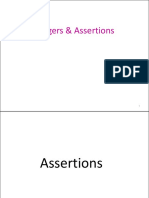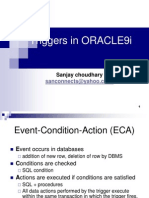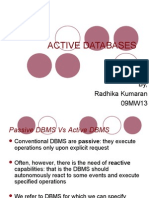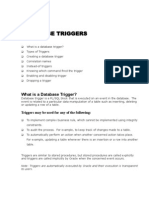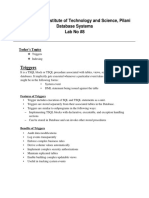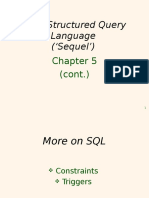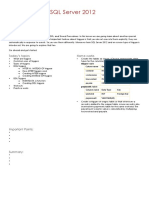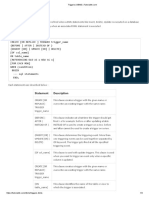0 ratings0% found this document useful (0 votes)
21 views16 pages5 Advanced Database Models, Systems, and Applications
The document discusses advanced database concepts, focusing on active databases and triggers, which are procedures that automatically execute in response to specific database events. It outlines the structure and types of triggers, including row-level and statement-level triggers, and their applications in various domains such as healthcare and finance. Additionally, it introduces temporal databases that manage time-sensitive data, emphasizing the importance of valid time, transaction time, and bitemporal data.
Uploaded by
neupanepratik1Copyright
© © All Rights Reserved
We take content rights seriously. If you suspect this is your content, claim it here.
Available Formats
Download as PDF or read online on Scribd
0 ratings0% found this document useful (0 votes)
21 views16 pages5 Advanced Database Models, Systems, and Applications
The document discusses advanced database concepts, focusing on active databases and triggers, which are procedures that automatically execute in response to specific database events. It outlines the structure and types of triggers, including row-level and statement-level triggers, and their applications in various domains such as healthcare and finance. Additionally, it introduces temporal databases that manage time-sensitive data, emphasizing the importance of valid time, transaction time, and bitemporal data.
Uploaded by
neupanepratik1Copyright
© © All Rights Reserved
We take content rights seriously. If you suspect this is your content, claim it here.
Available Formats
Download as PDF or read online on Scribd
You are on page 1/ 16
ADVANCED DATABASE
MODELS, SYSTEMS, AND
APPLICATIONS
> IE
comprehensive study of this chapter, you will be able to:
© Deductive Database Concepts
'etradaction to information Retrieval and Web Search,
228 Advanced Database
Active DATABASE CONCEPTS AND TRIGGERS
invoked by the DBMS in response to chang,
Sty
A trigger is a procedure which is automatically i
pI ministrator (DBA). A database with ie
the database, and is specified by the database ad b
associated triggers is generally called an active database. These databases are very diffcy,
be maintained because of the complexity that arises in understanding the effect of y.°
triggers. In such database, DBMS initially verifies whether the particular trigger speciieg
the statement that modifies the database) is activated or not, prior to executing the statemen, I
the trigger is active then DBMS executes the condition part and then executes the action Dart
i ‘oni activate more
only if the specified condition is evaluated to true. It is possible to than one trigg,
within a single statement.
‘Specification of events x conditions to
‘be monitored
‘Actions Queries and updates
‘Active DBMS
SS
External Events
Active database architecture
Figure
‘Triggers are executed when a specified condition occurs during insert/delete/update. Triggers
are action that fire automatically based on these conditions. Triggers follow an Event-condition
action (BCA) model.
+ Event: An event is a change to the database which activates the trigger. It is database
modification E.g., insert, delete, and update.
* Condition: A query that is run when the trigger is activated is called as a condition
It is any true/false expression. If no condition is specified then condition is always
true.
. Action: A procedure which is executed when the trigger is activated and its condition
is true. It is the sequence of SQL statements that will be automatically executed.
The syntax to create database trigger is as follows:
CREATE [OR REPLACE] TRIGGER
[BEFORE | AFTER | INSTEAD OF]
{DELETE| INSERT | UPDATE .......ON]
EERE) O Advanced Database Mod
els, Systems, i
{FOR EACH ROW] ls, Systems, and Applications 229)
HEN}
DECLARE
peclaration Part>
BEGIN
eBxecution Part>
EXCEPTION
‘eBxception handling part>
END;
Create or Replace: The CREATE keyword specifies that we are creating a new
trigger. The OR REPLACE keywords are optional. They are used to modify an
existing trigger.
, Trigger name: Specify the name of the trigger that we want to create after the
CREATE OR REPLACE keywords.
, BEFORE | AFTER: The BEFORE or AFTER option specifies when the trigger fires,
either before or after a triggering event e.g., INSERT, UPDATE, or DELETE.
|. ON Table_mame: The Table_name is the name of the table associated with the
trigger.
. FOR EACH ROW: The clause FOR EACH ROW specifies that the trigger is a row-
level trigger. A row-level trigger fires once for each row inserted, updated, or deleted.
Besides the row-level triggers, we have statement-level triggers. A statement-trigger
fire once regardless of the number of rows affected by the triggering event. If you
omit the FOR EACH ROW clause, the CREATE TRIGGER statement will create
statement-level trigger.
«WHEN (condition): This provides a condition for rows for which the trigger w ould fire.
This clause is valid only for row-level triggers.
+ The declaration part, execution part, exception handling part is same a5 that of the other
PL/SQL blocks. Declaration part and exception handling part are optional.
:NEW and :OLD Clause
Ina row level trigger, the trigger fires for each related row. And sometimes iis required to
now the velue before and after the DML statement, Oracle has provided two clauses in the
RECORD level trigger to hold these values, We can use these clauses t0 refer to the old and new
Values inside the trigger body.
a. INEW ~ It holds a new value for the columns of the base table/view during the tigger
execution:
b OLD - It holds old value of the columns of the base table/view during the tigger
execution
This clause should be used based on the DMI. event, Below table will specify which clause is
Valid for which DML statement (INSERT/UPDATE/ DELETE).
280 Advanced Database
INSERT UPDATE DELETE
NEWT VAUD 7a INVALID. There ino ne
value in delete case,
SOLD J INVALID. There isno old | VALID ALB,
value in insert case
Features of Active Database
Types of Triggers in Oracle
‘Triggers can be classified based on the following parameters,
1
2.
+ DDL Trigger: It fires when the DDL event is
* DATABASE Trigger: It fires when the d;
ROW level Trigger
A row
example, if an UPDATE statement updates mult
for each row affected by the UPDATE statement,
t possesses all the concepts of a conventional database ie. data modelling facilities, gy,
language, multi-user access, recovery, etc.
{t supports all the functions of a traditional database, including data definition, day
‘manipulation, storage management, transaction management, concurrency conto, ayy
crash recovery.
An active database supports definition and management of ECA-rules.
An active database must detect event occurrences.
An active database must be able to evaluate conditions and to execute actions,
‘An active database includes an event driven architecture (often in the form of ECA rules)
An active database must be able to evaluate conditions and to execute actions. This
requirement means that it has to implement rule execution.
Classification based on the level
* STATEMENT level Trigger: It fires one time for the specified event statement.
+ ROW level Trigger: It fires for each record that got affected in the specified event
(only for DML)
Classification based on the timing
+ BEFORE Trigger: It fires before the specified event has occurred.
+ AFTER Trigger: It fires after the specified event has occurred,
+ INSTEAD OF Trigger: A special type. You will lear!
(only for DML)
Classification based on the Event
+ DML Trigger: It fires when the DML event is specified
(INSERT/UPDATE/DELETE)
‘n more about the further topics.
specified (CREATEYALTER)
latabase event is specified
(LOGON/LOGOFF/STARTUPISHUTDOWN)
level trigger is fired each time the table is affected by the triggering’ statement. For
ple rows of a table, a row trigger is fired once
Tha triggering statement affects no rows, a roW
}O Advanced Database
is not run. Row triggers are useful ifthe code in the
oA. cower oe \¢ trigger action depends on data
s that are affected, Fi
erie that ses the values of each row affected by the t eae ering example iurtrater a
:
sample: Let us considera table whichis named Student
student (Sid, Sname, age, salary)
Node items andAppictons ga
wf
ving statement.
aysdeat__
fsia | Sname | Age | Salary
1 | Rajan | 33 | 20000
g | Aarav | 15 | 30000
3 | Kamala | 30 | 25000
7 [danaki | 43 | 60000
[at us now create a row-level trigger for the Student table that would get executed by the DML
statement like UPDATE, INSERT or DELETE on that table. The trigger will compute and show
the age difference between current and previous values.
CREATE OR REPLACE TRIGGER Age changes
BEFORE DELETE OR INSERT OR UPDATE ON Student
FOR EACH ROW
WHEN (NEW.Sid> 0)
DECLARE
age_diff NUMBER;
BEGIN,
age_diff = :NEW.age - :OLD.age;
dbms_output-put_line (Previous age:
dbms_output.put_line (Current a
dbms_output.put_line (Age difference:
END;
To fire the above trigger, we need to do any DML operation like DELETE, INSERT or UPDATE
on the table, Let us again insert some values in the Student table with the help of the below
query:
INSERT INTO Student
VALUES (6, ‘Aadesh’, 16, 99):
Once the INSERT operation is completed in the Student table, the trigger age changes gets
‘executed,
The output of the query code:
Age difference:
Since a new record is created and the previous age is unavailable, the previous age and Age
difference computation comes as null in the above output,
FBZ Advanced Database
Now, let us-modify a record with UPDATE statement with the help of the below query:
UPDATE student
SET age = age + 5
WHERE Sid = 4;
Once the UPDATE operation is completed in th
executed.
The output of the above query:
Previous age: 43,
Current age: 48
Age difference: 5
Statement level Trigger
A statement trigger is fired once o}
of rows in the table that the triggering stater
example, if a DELETE statement deletes several
trigger is fired only once. Statement triggers
depend on the data provided by the triggering
‘a statement trigger to:
* Make a complex security cl
© Generate a single audit record
1e Student table, the trigger age_changes go,
is
wn behalf ofthe triggering statement, regardless of the number
ment affects, even if no rows are affected. Por
1 rows from a table, a statement-level DELETE
are useful if the code in the trigger action does not
statement or the rows affected. For example, use
heck on the current time or user
Difference between Row level and Statement level triggers
‘Triggers al
re defined as stored programs which are automatically executed whenever some
‘events such as CREATE, ALTER, UPDATE, INSERT, DELETE takes place. They can te
defined on a database, table, view with which event is associated. Triggers can be broadly
classified into Row Level and Statement Level triggers. Broadly, these can be differentiated as:
Statement Level Triggers |
Row level triggers executes once for each
and every row in the transaction.
Statement level triggers executes only once for
each single transaction.
Specifically used for data auditing purpose.
Used for enforcing all additional security 0”
the transactions performed on the table.
“FOR EACH ROW” clause is present in
CREATE TRIGGER command,
“FOR EACH ROW” clause is omitted =
CREATE TRIGGER command.
Example: If 1500 rows are to be inserted
into a table, the row level trigger would
execute 1500 times.
‘Example: If 1500 rows are to be inserted into
table, the statement level trigger would
execute only one time,
‘Applications of Active database
. mnitorir ivitic
Data _monitomng activities such as CIM, Telecommunications Nev
work
Management, Program tradi ‘
trading, Medical and Financi isi rt System>
can greatly benefit from integration with active Ruane es Suppor
EAT O Advanced Database
| cd Database Models, Systems,
+ Production control, e., power plants i Spemwataepaten
+ Maintenance tasks, e.g,, inventory control,
+ Financial applications, e.g, stock & bond tra
ng.
+ Telecommunication and network management
» Air traffic control,
. Computer Integrated Manufacturing (CIM)
+ Statistics gathering and authorization tools.
weaknesses of active database
+ Insufficient methodological support in design and analysis.
+ Lack of standardization,
+ Missing development and administration tools for triggers.
Weak performance: This is one the main reasons that makes users reluctant to use
active rules in the development of large applications.
«Optimizing large applications is rendered difficult by the separation of transactions
and triggers and the misunderstanding of their subtle interactions.
+ Lack of Support for application development in many active database management
system prototypes.
= Distribution and Parallelism has not been widely treated as active databases have
een considered primarily in centralized database environments.
«The layered approach is beneficial in terms of construction cost, but the entire
system cannot be optimized comprehensively and this can cause runtime
performance to be worse than in an integrated architecture which is also very costly
to construct.
Temporal Database Concepts
Atemporal database stores data relating to time instances It offers temporal data types and
stores information relating to past, present and future time.
A Temporal Database is a database with built-in support for handling time sensitive data.
Usually, databases store information only about current state, and not about past states. For
example in an employee database if the address or salary of a particular person changes, the
database gets updated, the old value is no longer there. However for many applications, it is
important to maintain the past or historical values and the time at which the data was updated.
Thetis the knowledge of evolution is required. That is where temporal databases are useful. It
stores fnformnation about the past, presont and future, Any data that is time dependent is called
the temporal data and these are stored in temporal databases.
‘Temporal Databases store information about states of the real world across time. Temporal
Database ie a databewe with built-in support for handling data involving time, Tt stores
information relating to past, present and future time of all events.
| BBA Advanced Database
Examples of Temporal Databases
x the patients’ health history fop ,
* Healthcare Systems: Doctors nee
diagnosis, Information like the time a vaccination was given or the exact time yp
fever goes high ete. *
+ Insurance Systems: Information about claims, accident history, time
policies are in effect needs to be maintained.
: Reservation Systems: Date and time of all reservations is important.
* Finance: stock price histories need to be
* Personnel management: salary and position
maintained.
history need to be maintained
+ Banking: credit histories
There are following three types of time a
+ Valid time
* Transaction time and
+ Bitemporal time
vailable in temporal database:
Valid time
Valid time is a time period during which a fact is true in the real word.
articular time point or time period in the database, the
Given a particular event
or fact that is associated with a p:
association may be interpreted to mean different things. The most natural interpretation is that
the associated time is the time that the event occurred, or the period during which the fact was
considered to be true in the real world. If this interpretation is used, the associated time is often
referred to as the valid time. A temporal database using this interpretation is called a valid
time database.
For example, in a company the Salary of the employees have a valid time and end time
Valid Time Table
El Indra | 80000 | 2072-03-30 2073-03-30
El Indra | 90000 | 2073-04-01 2074-03-30
Er | Indra | 95000 | 20TH 04 OT 3075.08.30
EI | Tndra } 100000 | 2075-06-01 2077-08-80
El Indra | 150000 | 2077-04-01 2078-03-30
2 Bhupi | 65000 | 2072-03-30 2076-03-30
E2 Bhupi | 75000 | 2076-04-01 Now
E3 Rajan | 40000 | 2072-03.30 2078-03-30
Transaction time
‘Transaction time is the time period during which a fact stored in the database was known.
However, a different interpretation can be used, :
: , where the associated ti the time
when the information was actually stored in th: eae
¥ 1 database; that is, it is the valu
pally stored ; e of the system
time clock when the information is valid in the system. In this case, the associated time is called
0) Advances 4
Aalvanced Database Models, Systems, and Applications
stion time, A temporal r rprotation i transaction
the qatabase: U 7 p)hiera wy a ; mt :
Kk nck database, 1 p
, 4 company
me
dio ala of the employees have a valid time and ond time
ne
senso Time Table
so Nae | Sai TransnctTon Start ine [WaaaneiTon Bnd Mine
ft Indra 80000 -b
fl Indra | 90000
Tndra | 95000 | 2074-04-01, 10.221
BL | Indra_| ——_|
Tndra_| 100000
BL
ft Tada | 160000 | 2077-04-01, 10:10:46
p Bhupi | 65000 | 2072-03-90, 10:01:43) 2076-03-30, 11:12:28
BP Bhupi_| 75000 Now.
3 Rajan | 40000 2078-03-80, 09:48:33
Bitemporal data
itcombines both valid ad transaction time, It stores data with respect of both valid time and
In some applications, only one of the dimensions is needed and in other cases
transaction time.
are required, in which case the temporal database is called a bitemporal
both time dimensions
database.
Bitemporal Time Table
[Empino | Name | Salary | Transaction Time Valid Start Time | Valid End Time
EL Tnara | 80000 _| 2078-03-90, 10:02:39 | 2072.03-80 2073-03-30
El Indra | 90000 | 2078-03-30, 10:02:89 | 2073-04-01 2074-03-30
EL Tnara | 95000 _| 2078-03-30, 10:02:39 | 2074-04-01 2075-03-30
EL Tndra | 100000 | 2078-03-80, 10:02:33 2075-04-01
EL Tndra | 150000 | 2078-03-30, 10:02:38 2077-04-01
Be Bhupi | 55000 | 2078-03-30, 1 02:33 | 2072-03-30 2076-03-30
Ee Bhupi | 75000 _| 2078-03-80, 10:02:33 2076-04-01 Now
EB Rajan | 40000 | 2078-03-80, 10:02:33 2072-03-30 2077-08-30
Spatial Database Concepts
Aspatial database is a database that is enhanced to store and access spatial data or data that
defines a geometric space. These data are often associated with geographic locations and
features, or constructed features like cities. Data on spatial databases are stored as coordinates,
Points, lines, polygons and topology. Some spatial databases handle more complex data like
three-dimensional objects, topological covernie ‘and linear networks.
Spatial databases address many of the mitations of static data files. Spatial databases can
{entain lange amounte of data in erultiple tables with linking mechanisms that maintain data
eee eamenliee ott iritiona on data entry to Limit collection of ineonsiston’ data. As
fe Brom they ean span *raiiple physical machines as well ax maintain copies of themselves
which ey Spatial databases can also maintain ‘changes to a set of spatial data and track
sers are making edits for approval and auditing.
© 236 Advanced Database
{tis important to make the distinction between typical databases and spatial databases, Spay
databases are standard databases that have been extended to accept spatial data types any
queries. Spatial data types store feature geometry that describes shape and location, qy,
geometry of spatial features is compressed and stored in a binary field along with the attrituey
data that describe the feature. In addition, the database application code is extended 0 thay
typical queries using alphanumeric characters and logical operators are extended to tay
advantage of location, proximity, and topology. For instance, in a typical customer database
company might query for all customers whose last name begins with a certain letter. In a spatig,
database, they can query for all customers within proximity of a particular store or find clusters
of customers, These types of spatial transactions are not available in typical databases,
Examples of non-spatial data
The spatial data represent a geographical space. They are characterised by the point, lines and
the polygons, The point represents positional characteristics of the some of the geographical
features such as school, hospitals, wells, villages, towns etc. on the map.
Some examples of non-spatial data are:
= Names, phone numbers, email addresses of people ete.
Examples of spatial data
The data describing the spatial data is called as non-spatial or attribute data. For example if you
have a map showing position of your school you can attach the information as the name of the
school, number of students in each of the class, available facilities like library, Labs, Canteen,
Playground ete. In another word you will be defining the attributes of the spatial data. Thus
non-spatial data are also known as attribute data. Some examples of spatial data are:
= Weather and climate data
+ Rivers, Farms, ecological impact
+ Medical imaging
+ NASA satellites imagery-terabytes of data per day
(2) Hospitalization
Gid | Disease | Age | Gender | The Geom
1 [Cancer [23 | M Point.
2 | Infaret | 25 | M Point...
(b) Factory,
Gid_Name Address Business The
1 “GerdauXxonx Siderurgical Point.
2 Infaret Zzzz22 MetallurgicalPoint ...
(©) Cellular Antenna
Gid OwenberPower level Date The geom.
03/01/1999 Point, /
2° Vivo la 10,101/1995 Point...
GRRFTERS)O Advanced Database Models, Systems, and Applications | 287
7 goMBTRY_COLUMNS
@o
“eae set F table name F geometry column SRID
- Hospitalizat
nie pi ion The Geom -1
ible Factory ‘The_Geom “1
pete Cellular Antenna: ‘The_Geom avsssove -
Figure: Spatial Database
Multimedia Database Concepts
multimedia data that includes text,
audio etc. and have vast amounts of
different types of multimedia data
is known as multimedia database
Multimedia database is the collection of interrelated
graphics (sketches, drawings), images, animations, video,
mmultisource ‘multimedia data. The framework that manages
delivered and utilized in different way:
which can be stored,
‘management system.
Components of multimedia database
o store and query different types of
tudes images (such as photos oF drawings), video clips (such
dio clips (such as songs, phone messages OF speeches),
ff database queries that are needed
jects of interest. For example, one
stain person, say Michael
tivities included in them,
contents of &
Figure5.2:
Multimedia databases provide features that allow users t
multimedia information, which inch
‘8 movies, newsreels, or home videos), au
and documents (euch as books or articles). The mal? types o
involve locating multimedia sources that contain certain obj
may want to locate all video clips in @ yideo database that include a cet
Jackson. One may also want to retrieve video clips based on certain ac
such as video clips where a soccer goal is scored by a certain player or team. The ¢
nultimedia database management system can be:
* Media data: It is t
* Media format data: The informa!
te, about the format of the media
processing, and encoding is the me
he actual data which represents an object
tion such as resolution, sampling rate, encoding system,
lata under consideration after is undergoes acquisition,
.dia format data.
Challenges to multimedia databases
238
Advanced Database
Media keyword data: Media keyword dat des
generation of data, ‘This data is also known as content descriptive data. Examp,
content descriptive data are place, time, date of recording.
Media feature data: Media feature data contains data which is content dependeny
as kind of texture, distribution of, and the different shapes present in the data
a are the keyword description related »,
8 of
uh
Modelling: Work in this area can improve the database versus information retin
techniques. iret?
Design: The physical, conceptual, and logical design of multimedia databases jg ny
addressed entirely leading to performance and tuning issues.
Storage: The storage of databases on a standard disc can lead to problems tite
representation, mapping to disc hierarchies, compression, ete. 7
Performance: Audio-video synchronization and audio playback applications are where
physical limitations dominate, Parallel processing can reduce these problems, but thee
techniques have not been completely developed yet. Multimedia databases also consume a
lot of processing power and bandwidth.
Queries and Retrieval: Multimedia such as images, audio, video lead to retrieval and
queries issues such as efficient query formation, query execution, ete.
Multimedia Database Applications
Documents and record management: Industries which keep a lot of documentation
: Insurance claim industry.
and records.
Knowledge dissemination: Multimedia database is an extremely efficient tool for
knowledge dissemination and providing several resources. Ex: electronic books
Education and training: Multimedia sources can be used to create resources useful in
education and training. These are popular sources of learning in recent days. Ex: Digital
libraries.
Real-time monitoring and control: Multimedia presentation when coupled with active
database technology can be an effective means for controlling and monitoring complex
tasks. Ex: Manufacture control
Marketing
‘Advertisement,
Retailing
Entertainment
‘Travel
oo 000
Deduetive Database Concepts
ae database is e database system that can make deductions (ie, conclude additional
a ai ped rules and facts stored in the (deduetive) database, Datalog is the language
tic to specify facts, rules and queries in deductive databases. A deductive database
an be defined as an advanced database augmented with an inference aysto
system,
Database + Inference = Deductive database
ing rules against facts, new fi i ich i
evaluating . new facts can be derived, which in t
vex Ie makes a database system more powerful pan cin boned a ener
', anfustive database system we typically specify rules through a declarative langua
in which we specify what to achieve rather than how to achieve it. An inference engine
beecstion mechanism) within the system can deduce new facts from the aise te
Sepeeting these rules. The model used for deductive databases is closely related to the
Tonal data model, and particularly to the domain relational caleulus formalism It is also
Spas tothe eld of logic programming and the Prolog language. The deductive database work
ion logic has used Prolog as a starting point. A variation of Prolog called Datalog is used to
‘Shoe rules decaratively in conjunction with an existing et of relations, which are themselves
as literals in the language. Although the language structure of Datalog resembles that of
seated
Brelos. its: operational semantics—that is, how a Datalog program is executed—is still different.
|4dadustive database uses two main types of specifications: facts and rules. Facts are specified
ey manner similar to the way relations are specified, except that itis not necessary to include
Sb. attribute names. Recall that a tuple in a relation describes some real-world fact whose
sraning is partly determined by the attribute names. In a deductive database, the meaning of
Er otiribate value in a tuple is determined solely by its position within the tuple Rules are
Sehet cimilar to relational views. They specify virtual relations that are not actually stored
a shat can be formed from the facts by applying inference mechanisms based on the rule
specications. The main difference between rules and views is that rules may involve recursion
Sy hence may yield virtual relations that cannot be defined in terms of basic relational views.
jennifer
ee yee acai
Facts
Supervise (Frankin, john)
‘Supervise (Frankin, Ramesh)
Supervise (Frankin, Joyce)
Supervise (James, Frankin)
Supervise (Jennifer, Alicia)
Supervise (Jennifer, Ahmad)
Supervise (James, Jennifer)
Rules
‘Superior(X, Y) — supervise (X, Y),
Superior(X, Y) — supervise (X, Z), superior 2, Y),
‘Subordinary(X, Y) — superior (¥,X)s
PAD Advanced Database
Introduction to Information Retrieval and Web Search
yenta from a colter
Information retrieval is the process of retrieving docu
query (or a search request) by a user.
Information Retrieval is the nctivity of obtain
unstructured nature i.e. usually text which satisfies an information need from with,
collections which is stored on computers. For example, Information Retrieval can by then a
enters a query into the system.Nowadays hundreds of millions of people engage in I eer q”
when they use web search engines. Information Retrieval is believed to be the dominant forg
Information access. The IR system assists the users in finding the information they require,
it does not explicitly return the answers to the question. It notifies regarding the existones ay,
Jocation of documents that might consist of the required information. Information retrieval, |
extends support to users in browsing or filtering document collection or processing a set ¢ |
retrieved documents,
Document
cropus
ction nen
Pon,
“y
material that enn usually be documenta
Documents,
Figure 5.3: Information retrieval architecture
An IR system has the ability to represent, store, organize, and access information items. A set of
Keywords are required to search. Keywords are what people are searching for in search
engines. These keywords summarize the description of the information,
System User
Figure 5.4:
flow chart of information retrieval
1 GHAFTERS) 0 Advanced Database Models, Systems, and Applications 20
‘Acquisition: In this step, the selection of docu ,
i ments and other objects from various web
resources that consist of text-based documents takes place. The required data i rellete
py web crawlers and stored in the database, —
Representation: It consists of indexing that contains free-text terms, controlled
* *, “ 7
vocabulary, anual & ounces techniques as well. Example: Abstracting contains
summarizing and Bibliographic description that contains i .
author, ti
summaries or, title, sources, data,
File Organization: ‘There are two types of file organization methods. Le.
Sequential: It contains documents by document data. Inverted: It contains term by
term, list of records under each term. Combination of both.
Query: An IR process starts when a user enters a query into the system. Queries are
formal statements of information needs, for example, search strings in web search
engines. In information retrieval, a query does not uniquely identify a single object in
the collection. Instead, several objects may match the query, perhaps with different
degrees of relevancy.
Difference between Information Retrieval and Data Retrieval
‘Information Retrieval Data Retrieval
The software that deals with the| Data retrieval deals with obtaining data from
organization, storage, retrieval, and] a_database management system such as\
evaluation of information from document] ODBMS. It is a process of identifying and
repositories particularly textual information
js called information retrieval.
retrieving the data from the database, based
on the query provided by user or application.
Retrieves information about a subject.
Determines the keywords in the user query
and retrieves the data.
‘Small errors are likely to go unnoticed.
“Asingle error object means total failure.
Not always well structured and is
semantically ambiguous.
Has a well-defined structure and semantics.
Does not provide a solution to the user of the
database system.
Provides solutions to the user of the database
system.
‘The results obtained are approximate
matches,
‘The results obtained are exact matches.
Results are ordered by relevance.
Results are unordered by relevance.
Itis a probabilistic model.
Tt is a deterministic model.
Quem
1. What are the uses of active database? Discuss active database with example.
2 Discuss some applications of active database. How do spatial database fer from regular
database?
3. Why do wo need temporal database? Discuss valid time, transaction time and bi-temporal
relations.
10,
uu.
12.
13.
4.
16.
16.
7.
18.
19.
20.
AN
Advanced Database
What is active database? Discuss generalized mode for active databases?
Discuss how time is represented in temporal databases and compare the
. 5 Mt tin
dimensions. time
What is temporal database? Explain the terms date, timo, timestamp, interval and ug,
Define concept behind trigger. How statement level trigger differ from row level tpg 4
Explain, rs
Define deductive database, Write down their applications and importance,
What do you mean by information retrieval? Explain concept of IR in web search,
What is the application of temporal database? Describe different types of time coayy i,
temporal database,
Define multimedia database. Describe challenges on multimedia database. Also desert,
their application areas.
What is multimedia database? What are the nature of multimedia database ang
applications?
Define multimedia database, Discuss benefits of multimedia databases. How do you query
image database?
What are the uses of active database? Discuss active database with example.
What is structured data and what is unstructured data? Give an example of each from
your experience.
Give a general definition of information retrieval (IR). What does information retrieval
involve when we consider information on the Web?
Explain the main differences between the database and IR systems.
What are the differences between row-level and statement-level active rules?
What are deductive databases? What are the differences among valid time, transaction
time, and bi-temporal relations?
Describe how the insert, delete, and update commands should be implemented on a valid
time relation.
ooo
You might also like
- Procedural Extension To SQL Using Triggers - Lecture 2: DR Akhtar AliNo ratings yetProcedural Extension To SQL Using Triggers - Lecture 2: DR Akhtar Ali28 pages
- Lecture 3.1.3 - Introduction To Triggers Lecture 3.1.4 - Implementation of TriggersNo ratings yetLecture 3.1.3 - Introduction To Triggers Lecture 3.1.4 - Implementation of Triggers28 pages
- Lecture 3.3 - Introduction To Triggers Lecture 3.4 - Implementation of TriggersNo ratings yetLecture 3.3 - Introduction To Triggers Lecture 3.4 - Implementation of Triggers41 pages
- Triggers: Birla Institute of Technology and Science, Pilani Database Systems Lab No #8No ratings yetTriggers: Birla Institute of Technology and Science, Pilani Database Systems Lab No #811 pages
- What Is A Trigger?: Syntax of Triggers Syntax For Creating A TriggerNo ratings yetWhat Is A Trigger?: Syntax of Triggers Syntax For Creating A Trigger16 pages









